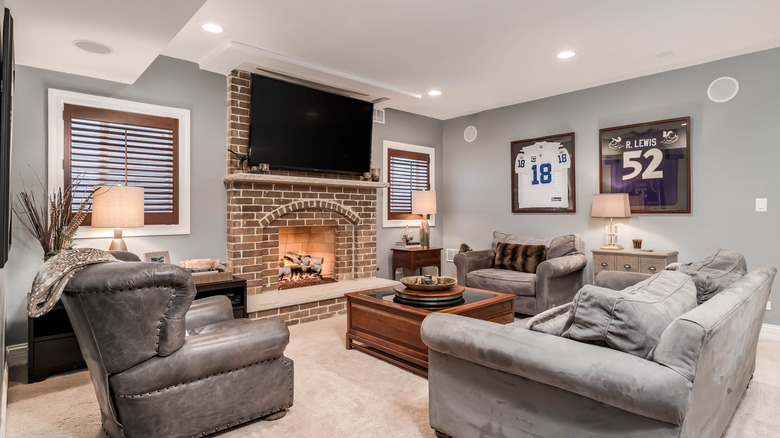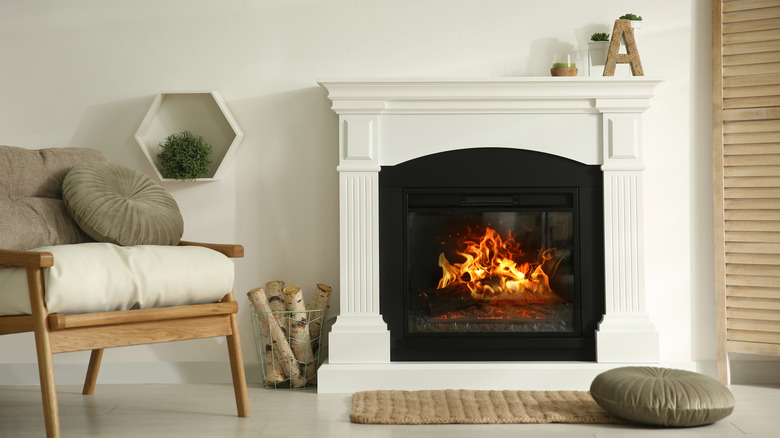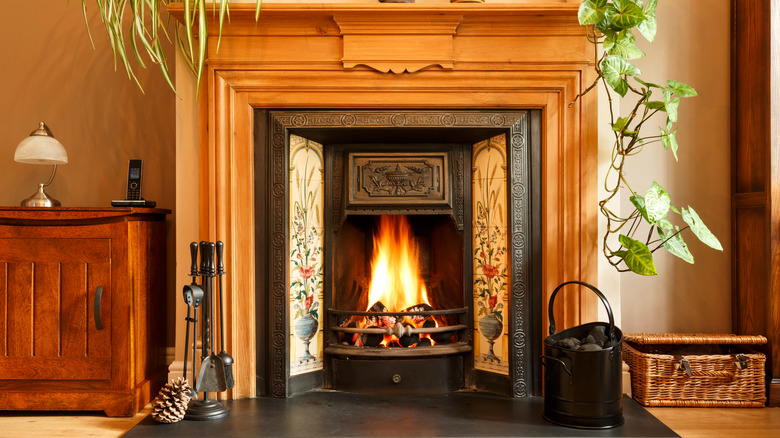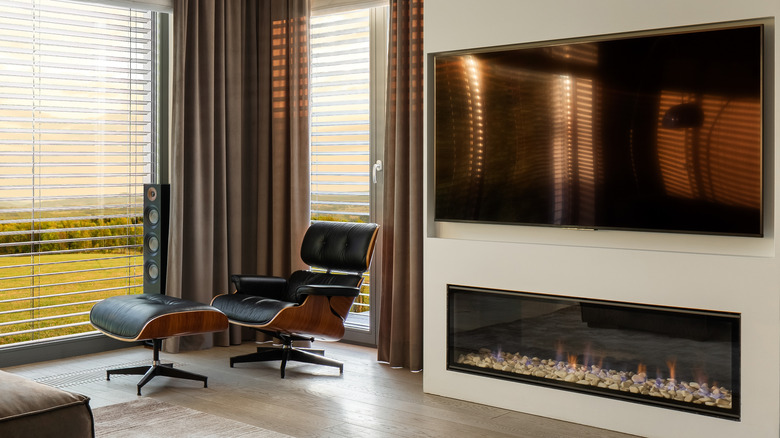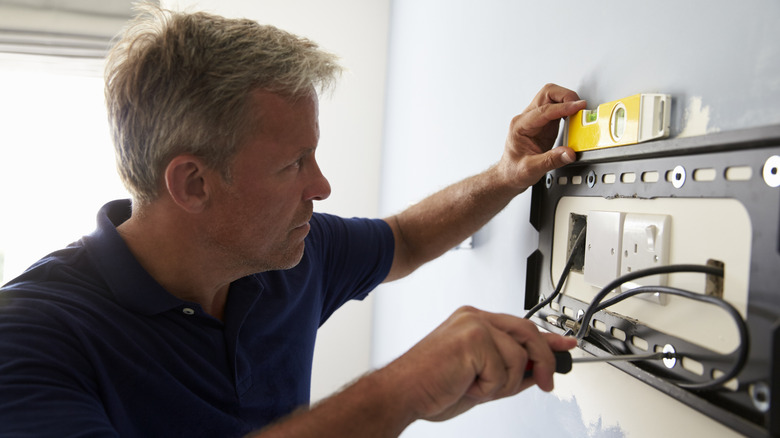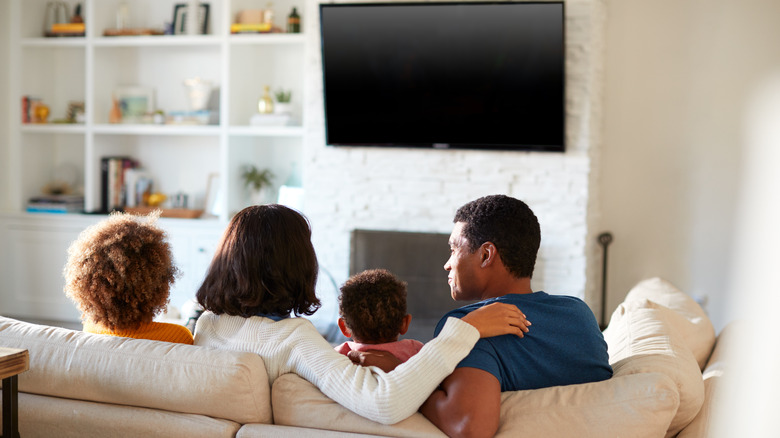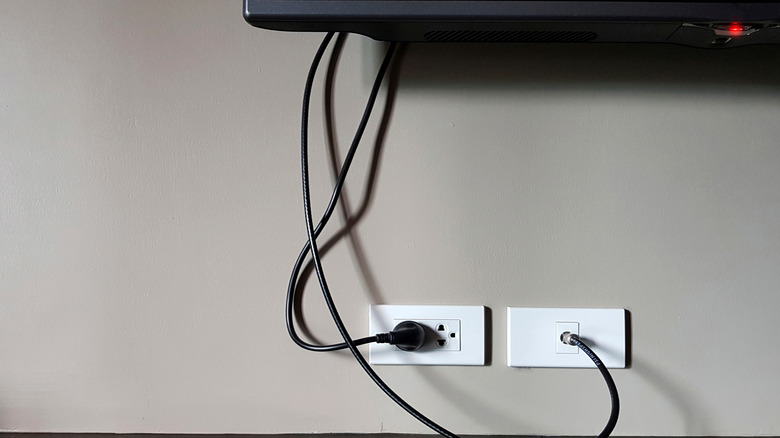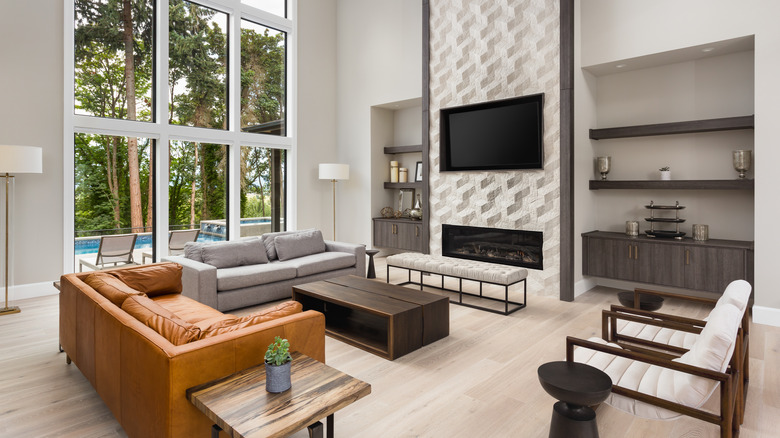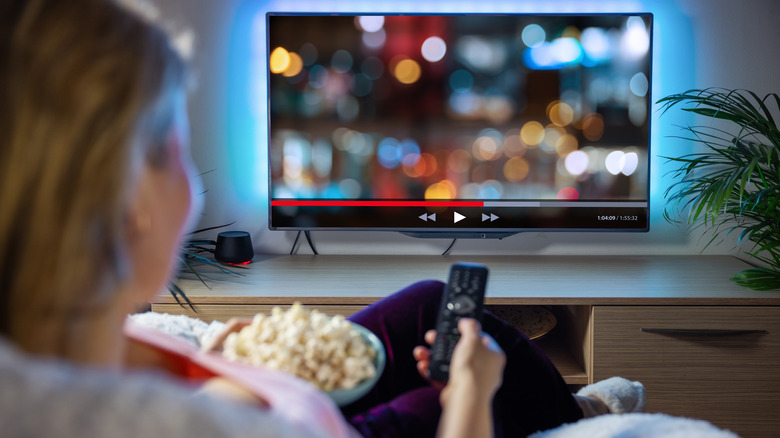10 Genius Tips For Placing Your TV Over A Fireplace
There's no denying that TVs look a lot different now than when they first hit the market. As Weight of Stuff reports, before LCD and flat-screen TVs became the norm, earlier cathode-ray tube TVs could weigh up to 100 pounds. Luckily, advances in technology mean that weight has decreased significantly over the years, with many standard flat screens clocking in at just 25 to 30 pounds. This change means there are far more options regarding where and how you place your TV in your home.
While some still prefer to place their TV in a standard entertainment center unit, many prefer the streamlined look and freed up floor space that comes along with mounting a TV on the wall. For many individuals who have a fireplace in their living room or theater room, above that feature tends to become the default option for where to mount it. After all, shouldn't it go near what is arguably the focal point of the room? Though many choose to mount their TV over a fireplace, there are a few things you want to consider before doing so. Here are 10 genius tips to keep in mind when placing your TV over a fireplace.
1. Examine the type of fireplace you have
Before placing your TV above your fireplace, consider what type of fireplace you have. As Bob Vila explains, some electric fireplaces are created solely for ambiance and barely put off any heat, and then there are electric fireplaces that generate a bit of heat. There are also gas fireplaces that put off quite a significant amount of heat, and then, of course, there are the real, crackling wood fireplaces that literally feature a roaring flame below your television.
Wood fireplaces are without question the riskiest to put a TV above, as you would have to consider everything from the heat level to potential accidents in case any sparks land on the television. However, even gas and many electric fireplaces come with heat hazards when you combine them with electronics. Ensure you have a good understanding of all the quirks and details of your particular fireplace.
2. Make sure the temperature is okay
So, you know your fireplace puts off some heat — but do you know exactly how much? When pairing that particular home feature with electronics, it's important to know the exact temperature above the mantel and not just what it feels like when you're sitting on a couch across the room. As Better Homes & Gardens reports, putting the TV near heat that exceeds the recommended temperature indicated in its manual is not only dangerous but can potentially void your TV's warranty as well. And nobody wants that to happen.
Take the time to measure the surface temperature of the spot where you'd like to place the TV. You can easily do this by taping a thermometer onto the wall and watching just how high it climbs. After all, you have likely never checked the temperature of that specific spot. It may be a whole lot hotter than expected.
3. Measure the distance between TV and fireplace
One of the most important factors for determining where to place your TV is the distance between the fireplace and the television. According to Fireplace Tips, there should be at least 20 inches of space between your fireplace and your TV. Note that this doesn't mean from your TV to your mantel — the measurement refers specifically to the fireplace's core, where all the heat is emitted.
While you don't want to be straining to look upwards at a TV mounted ridiculously high, you do want to try to leave as much space between the TV and fireplace as possible. This can help with any issues you might have with overheating and the like. If you'd prefer to place your TV atop a mantel, but your fireplace doesn't have one, you might even consider adding one for a decorative touch that will help with your TV placement goals.
4. Sketch out a blueprint and test it before drilling
The last thing you want is a bunch of holes that need repairing above your fireplace, which were created after you didn't get the spot right on the first (or second, or third) try. Before you drill anything into the wall to mount your television, make sure you know exactly where you want everything to go.
Apartment Therapy shared a helpful hack to nail down the placement of your TV, and it involves cardboard. Cut out a piece of paper or cardboard the size of your TV and tape it in the spot where you think you'll be mounting the device. This will give you a better idea of what the placement will look like and what the viewing experience will be like. After all, it's a lot easier to move around a lightweight piece of paper than a big TV.
5. Decide how you're going to mount it
The method for mounting your TV will depend on a lot of factors, from what architectural features your fireplace has to what material your fireplace itself is made of. But regardless of how you position your TV, you'll likely need to mount it. This means you will need to consider the hardware you may require, as The Big Screen Store explains.
For example, you won't want brackets that will look terrible from certain angles in the room. Instead, you will want brackets that will hold the TV flush against the wall. You also need to consider the material you're working with. You'll need a very different set of tools and hardware if you're looking to mount a television on a regular drywall surface versus if you're trying to set it up above a brick fireplace. There are even some situations where you may need it installed by a professional.
6. Examine the viewing angle
In many scenarios, the height of your ceiling plus the height of your fireplace means that your TV will have to be mounted relatively high to fit above the fireplace as desired. While this might work out in rather large spaces, in many other spaces, it'll mean straining to look upwards at the TV.
Before you commit and mount your TV above your fireplace, you may want to examine the room's viewing angles truthfully. Sure, you may like the way it looks, but if you end up with a headache every time you settle in to watch your favorite show, the placement just isn't serving you. Better Homes & Gardens suggests mock-watching the spot you're thinking of putting the TV for a few minutes. If you start getting neck strain in that short period of time, you might have to place the TV somewhere else in the room.
7. Consider a tilting mount
If you've decided you absolutely must place your TV above your fireplace despite the room's layout not being too conducive to that choice, one suggestion from Apartment Therapy is to consider using a tilting mount for your TV. There are many options on the market with slightly different appearances and weight limits, so you should be able to find one that works perfectly for your needs.
While the range of motion will vary according to the specific tilting mount you buy, in general, you'll be able to adjust your TV so that it's more comfortable to view, no matter where you sit in the room. This way, even if your couch is off-center, or if the TV is a bit too high because of the height of the fireplace, you can angle your TV so that you can see the picture clearly without straining your neck.
8. Find a way to conceal or organize any cables and wires
The last thing you want is a mess of cables and wires cluttering the look of your gorgeous fireplace and sleek TV. If you happen to be lucky enough to have a recessed alcove with an electrical outlet built-in, you can hide the wires and cables right behind the TV, as eFireplaceStore suggests.
Otherwise, you may have to find some creative solutions to get those wires out of the way. Country Living recommends hiding the wires in a well-styled bookcase that flanks the fireplace, or even in a well-positioned basket or box of some sort. You could also use simple solutions like zip ties or cable covers to streamline the appearance. Ultimately, it depends on how many cords and wires need concealing and the layout around your TV. Either way, visible wires are something you'll want to take into consideration when planning your placement.
9. Incorporate your aesthetic with design choices
Just because you've decided to mount your TV above your fireplace doesn't mean your TV has to be the focal point of the whole room. However, the sheer size of many TVs often means that's exactly what ends up happening. Luckily, a few design tricks can help you out a bit. Better Homes & Gardens has a few suggestions. If your TV is ruining your home's aesthetic, you may want to get a panel that rises or falls to either hide or expose the screen. When not in use, it'll just look like part of the wall.
If that is too technical for you, you can also strategically use furniture such as bookshelves to frame the fireplace and give the overall space a more intentionally designed aesthetic. After all, if your eye is drawn to the carefully arranged vignettes on your styled bookshelf, it won't be as tempted to linger on the big screen in the middle.
10. Flickering lights and screens don't always mix
The last thing to consider when placing your TV over the fireplace is the impact that fireplace might have on the image quality itself and your viewing experience in general. As The Spruce explains, any ambient lighting, especially when it flickers or moves as real or simulated flames do, can seriously impact the picture quality. This can especially be annoying if you're trying to really enjoy a cinematic experience and have all the lights off apart from your fireplace.
You may be lucky enough that the positioning of your TV means it isn't an issue, but in many scenarios, you'll find it has an impact — and not a good one. Consequently, while testing for angles and heat, you'll also want to test for glares to ensure that the TV screen isn't in a spot that gets a ton of light from the fireplace's flames.

